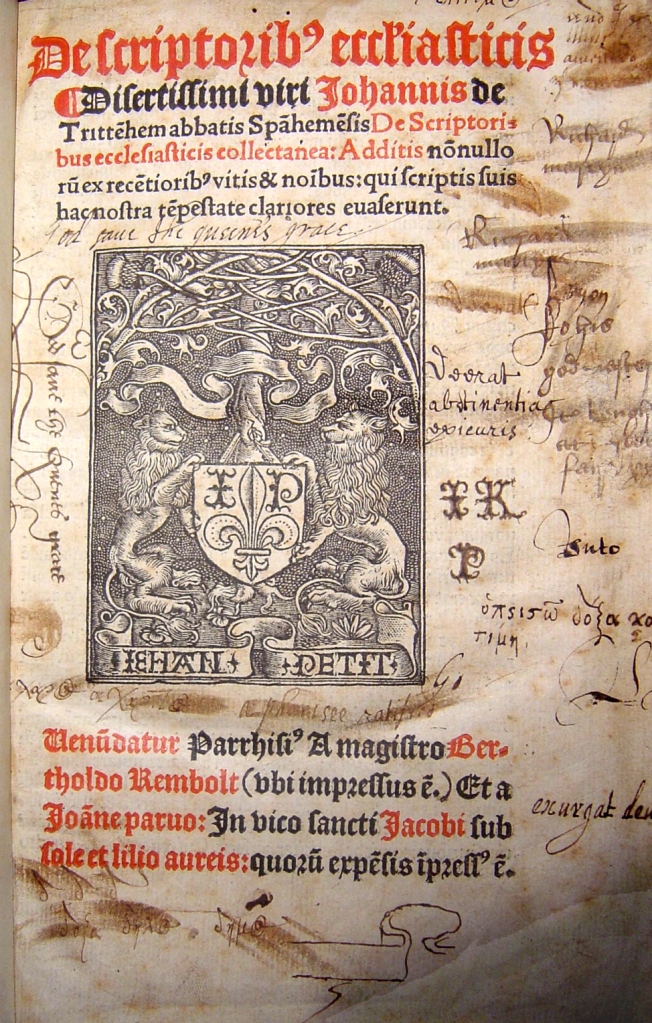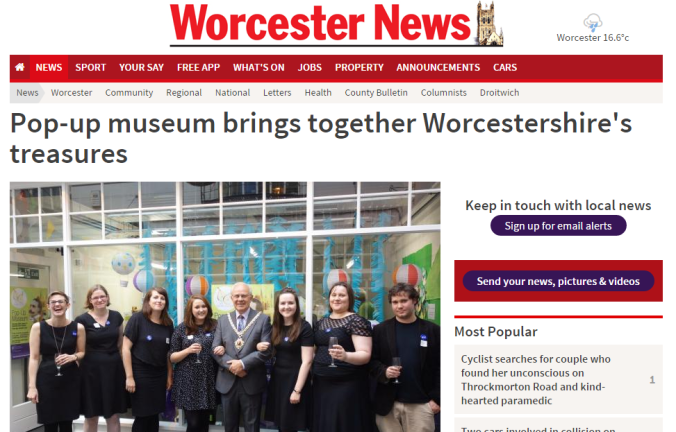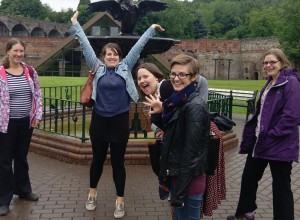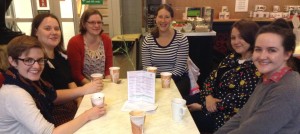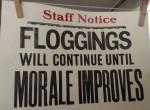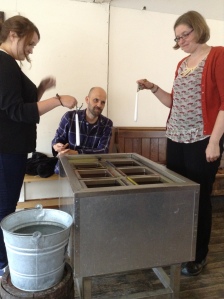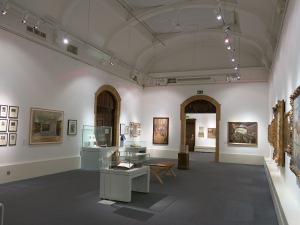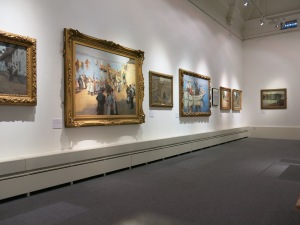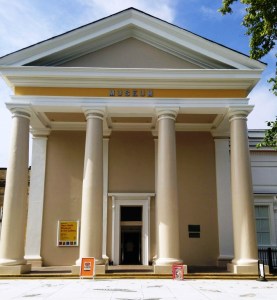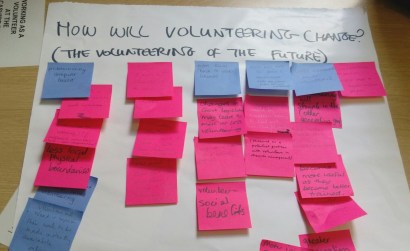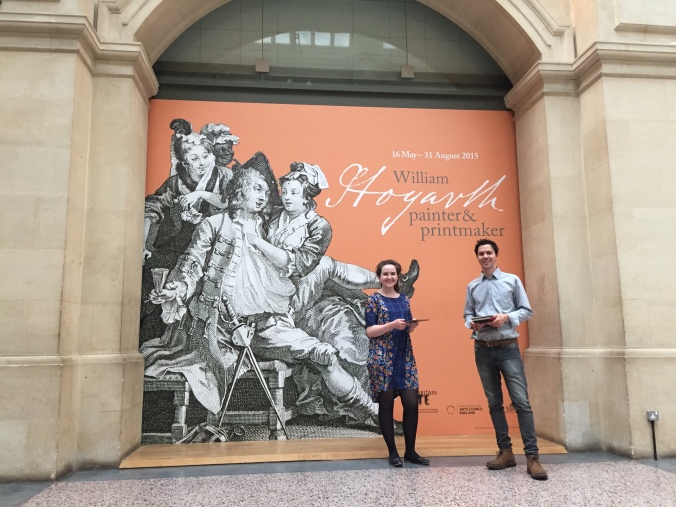To enhance their learning, trainees from later stages of the project published blog posts reflecting on their experiences.
So long and thanks for all the cake
It seems somewhat odd writing about the end of my traineeship, as I’m still here at the desk where I’ve sat over the past 15 months, continuing work on the same projects I’ve been chipping away at during this time. I’ve become very fond of my little corner at MAG and I’m pleased to say that I’ll be staying for the next few months.
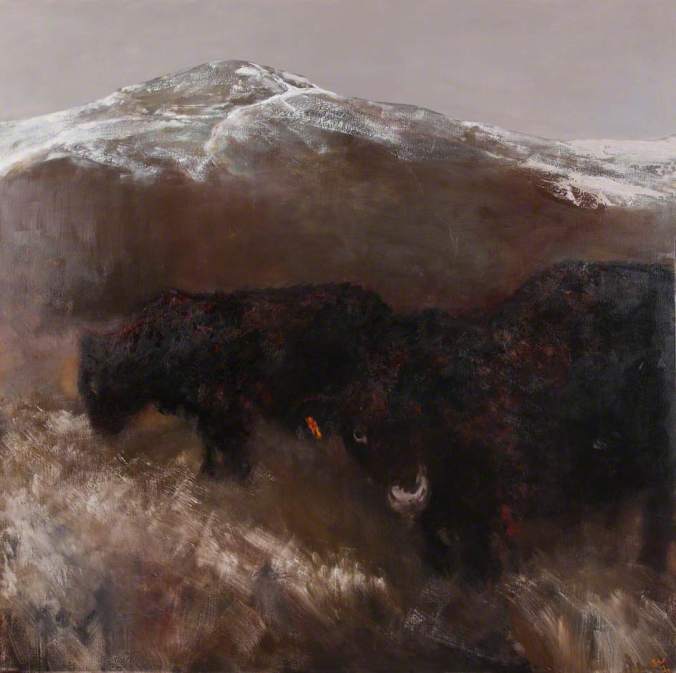
Bridget Macdonald, Winter Cattle, image supplied by The Public Catalogue Foundation, Worcester City Collection
During this time I will be working on three exciting new exhibitions, but at the moment I am mostly focused on This Green Earth: Bridget Macdonald and the landscape tradition of Claude Lorrain, Samuel Palmer and Peter Paul Rubens (Worcester City Art Gallery and Museum) 13th February — 25th June 2016) a loan-based exhibition with incredible artworks coming from Ashmolean Museum and Manchester Art Gallery. The show will explore the timeless yearning for elusive peace and tranquillity of rural life that underpins landscape art. I will also be making my first steps into curating medical and social history, working on A Happy Convalescence (Worcestershire County Museum at Hartlebury Castle, March 12th 2016 – late 2018), which will bring together years of research from historians involved in the Worcestershire World War 100 project to share the stories of the nurses and wounded soldiers at Hartlebury Castle during it’s time as a Voluntary Aid Detachment hospital.
Last week, on Wednesday 21st October, we marked the end of the final Worcestershire’s Treasures Skills for the Future project at an event at Worcester Guildhall. It was a great opportunity to celebrate everything that the scheme has achieved over the last four years and share to what it has meant to each of us. But it was also quite a sad moment, saying goodbye to ‘The Treasures’ who are leaving for exciting jobs further afield and marking the end of a project that has given so much us and to Worcestershire’s heritage industry.
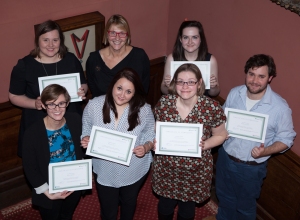
The final tranche of Worcestershire’s Treasures trainees with Sue Beardsmore from Heritage Lottery Fund
I have had the most fantastic time over the last 15 months, the amount I have learned, achieved and developed as a person has been incredible. I cannot overstate how grateful I am to Heritage Lottery Fund and the Worcestershire’s Treasures team for the opportunity. I am, most of all, hugely grateful to Philippa and everyone at Museums Worcestershire for their support, knowledge, kindness and professionalism.
Because of the Skills for the Future project and the support of the Museums Worcestershire team, I have progressed from an editor and aspiring museums professional to a qualified, experienced and confident curator. On top of the pleasure of working in heritage, I am also very happy to be able to continue supporting the brilliantly resilient and ambitious Museums Worcestershire and continue working at Worcester Museum and Art Gallery, which has become like a second home to me.
Emalee Beddoes
The End is Nigh
As we near the end of our traineeship we are busy completing projects, thinking about all we have learnt on our placements, and applying for new jobs. My last few projects at Worcestershire Archive and Archaeology Service are a hand over pack for my absent voter project, photographs for the Explore the Past leaflet I have designed and a project to catalogue and care for the Kinver archaeology Collection.
The Absent voters from 1918 are being transcribed by a loyal band of volunteers I recruited and trained. I have supported them as they completed the work and congratulated them as they finished one book and moved to the next. But they in turn have supported me as I wrote up the project for my PG cert assignment. Now the volunteers know what they are doing I just need to leave a pack for my colleagues who will take over supervising the project.

A photograph of Sarah with volunteer David Bonnick taken by David Tyrell – for the Explore the Past leaflet
Meanwhile I have been running around trying to rope in photographers and models for some photographs to advertise the service. The staff and volunteers at WAAS, their children, and some students from the university as well as Tom from the Cathedral library, all kindly helped by posing for photographs, and I was lucky to find two very talented photographers to take the pictures. I have been researching and writing the leaflet for months, so it’s been lovely to get the last bit completed, and now it’s on the way to the printers.
And the archaeology project has given me a chance to learn more about the Heritage Environment Record, and to input items into it, while learning some more about archaeology. At the same time I have reinforced some of the skills I have previously learned in archival care and conservation, finally getting my head around how to make boxes to fit the archives.
It’s a little sad as each individual trainee departs on their new journey, but great for the project to revel in our success and I am really looking forward to my own new roles as I continue to apply all that I have learned here. I feel really lucky to have had this opportunity to work with so many experts at WAAS, and to be leaving the role to continue working within heritage.
Sarah Ganderton
Coming to the End
We all knew from the start that the traineeships were fixed term contracts, but fifteen months seemed such a long time. That was now fourteen and a half months ago. The time has absolutely flown by – as it tends to do when one is having fun – and I sometimes wonder what I did with it all. The answer would be quite a lot!
With four exhibitions, a major collections decant, the setting up of a pop-up museum and the studying for a postgraduate certificate, this year has certainly been a busy one. Add to that the general day-to-day running of the library, the delivery of tours, answering enquiries and running a social media presence, and it soon becomes clear just how much I have achieved as part of this traineeship.
I have been able to learn new skills – in volunteer management, in palaeography, in digital image editing, cataloguing, preventative conservation and public speaking – while keeping my existing abilities in Latin and research skills nice and sharp.
Then there have been the discoveries I have made and the institutional knowledge about the collection that I have been able to add to – whether through finding (perhaps) the first evidence of Hops being grown in England or discovering that some of our books were once owned by important Elizabethan courtiers! It’s been great to share these findings with a wider audience through the library blog, and I’m currently training up some volunteers to keep it running after I’ve gone – do keep up with it here: https://worcestercathedrallibrary.wordpress.com/ !
I’m due to start my new job as a Project Research Assistant at Guildford Museum in early November. I’m very excited to be starting my new role, and have no doubt that my traineeship will have prepared me very well for it. I will, however, thoroughly miss the library and its collection. That’s not even to mention the staff here and the volunteers! To everyone involved in the traineeship – I thank you from the bottom of my heart for what has been the most fascinating and illuminating period of my life so far!
Tom Hopkins
My Worcester Pop-Up Museum – Marketing and PR
As Sarah mentioned in her post below, last month saw us hosting our ‘pop-up’ museum in Reindeer Court in the city. My role in the team covered marketing and PR. It’s probably worth saying now that when we began this project I had no formal training in either area, so my methods may not have been conventional, but I am pleased with the outcomes, and like the rest of the traineeship, the project was a great learning experience!
To begin, I put together a marketing strategy which was separated into online/external/print/shop. One of the things I did, following our group training session with a freelance PR consultant, was to write a number of press releases, and we gained coverage in Worcester News, the Worcester Observer, and on BBC Herefordshire & Worcestershire radio – a huge thank you to the two Kens who were involved in the project and took time out of their day to come and speak to journalists. I was particularly pleased as Helen, who delivered our training session, said we should aim for two pieces of coverage, so that was surpassed (just!) As nothing like this project had been done before, it was quite difficult to make predictions for both the amount of coverage and number of visitors we could expect.
I think if I were to take on a similar role again, I would probably do some more research into marketing and PR methods to begin with, I would give myself a longer lead-in time, and I would hopefully have more time to work on creating and sourcing content for our online platforms. That being said, I know we were all really pleased with the visitor numbers we had (c.250 over three and a half days), and many of those visitors had come to us intentionally, rather than just coming in after walking by, which I think demonstrates that the marketing was effective. It almost goes without saying, though, that the project was a group effort and so our collective work was what made it success, so well done to my fellow trainees, we did it!
Rachel Murphy
Popping up in Worcester
This week is the culmination of our project as the My Worcester Pop-up Museum goes live in Reindeer Court. We are opening to the public from Thursday 20th, Friday 21st and Saturday 22nd August 11am to 3pm, with an exhibition and FREE activities for all ages.
For several months now all the trainees have been working hard on the pop-up museum as part of the Worcester Festival. It’s been exciting, terrifying, enjoyable, nerve-racking and fascinating all at once. Such a project had not been tried by the previous tranches of trainees so we are breaking new ground while we learn new skills.
The exhibition highlights favourite treasures from each placement chosen by our volunteers and visitors. At Worcestershire Archive and Archaeology Service and the University of Worcester Special Research Collections we don’t normally have artefacts on display so we took the opportunity to create an exhibition on level 2 of the Hive.
I visited a couple of other institutions to work out how to create this exhibition. I was welcomed by Birmingham Museum and Art Gallery where Katie Hall had kindly organised for staff to talk to me about planning, setting up, and marketing a large exhibition. I chatted to the conservator about looking after the artefacts on display and sat in on a planning meeting. Then I visited Droitwich Spa Heritage Centre where Becky Pye and her band of volunteers let me sit in on a day’s worth of museum management while I marvelled at the temporary exhibition there.
Fired up with inspiration from both placements I created the exhibition now on level 2 of the Hive to showcase the Hanbury Hall Map Book (1732) chosen at Worcestershire Archive and Archaeology Service and a copy of Where the Wild Things Are from the University of Worcester Special Research Collections. This mini exhibition can be viewed until the end of August.
It has been brilliant to work together as a team with all the other trainees on this project. Now all the hard work is done, and we can enjoy welcoming customers to our pop-up museum in Reindeer Court: Thursday 20th to Saturday 22nd August, 11am to 3pm. Why not pop in and check it out for yourself?
Sarah Ganderton
Inspirational Ironbridge
The trainees had a lovely day in Ironbridge. We visited a couple of the museums to see how they run and what exhibits they have on display. But this was also a chance to meet professionals to discuss their careers and our own aspirations, with an emphasis on engagement.
Tamsin Bapty (nee Rowe) was in the first tranche of Worcester’s Skills for the Future Trainees and is now the Curatorial Officer for Collections Development working in the Museum’s Library & Archives where she keeps busy meeting celebrities. Tamsin met us for a coffee and a chat about life after a traineeship. Going out into the real world and getting a job is something we are all thinking about now our assignments are complete. Tamsin is clearly enjoying her new role and is doing well, so it was lovely to get a positive perspective on our prospects. She kindly gave us a tour of the blast furnace which is one of the reasons the Ironbridge Gorge is a UNESCO World Heritage site.
Then importantly for our learning experience we all had a go at candle-making,while Hugh Simmons talked to us about education at Blists Hill. We discussed some of the ideas that have worked, how he comes up with ideas, and how these are adapted for summer holiday activities. This includes candle making, soap making and typesetting and printing workshops.
And last but not least we met Laura Simcox, who is a recent graduate from another cultural apprentice scheme. Laura is the Special Events and Corporate Hospitality Assistant at Ironbridge Gorge Museum Trust, and runs events at Blists Hill. Meanwhile she is also working in her own time on a masters course and kindly talked us through her role at Blists Hill as well as discussing her course at Leicester.
It was a great day and we all came away feeling inspired for our future careers and ready to start filling in lots of job applications.
Sarah Ganderton
Stanhope Forbes’ England – Evaluation
It’s been nearly two months since the artworks for Stanhope Forbes’ England went back to their owners and one year since we began the Skills for the Future traineeships, so I have been reflecting on all that I have learned.
As part of evaluating the exhibition, I hosted a swap shop, introducing the trainees to the principles of front-end, formative and summative evaluation before we spent a few hours observing visitors to Stanhope Forbes’ England. From these observations and evaluating visitor numbers and the comments book we now know that:
- There were around 19,000 visitors to the building during the duration of the exhibition
- 81% of visitors came specifically for the Forbes exhibition
- 51% of visitors came from outside the WR postcodes
We also received some inspiring comments in the visitor book, including:
“Thank you for bringing this exhibition to Worcester”
“Excellent exhibition. Inspires me to find out more.”
“Chadding in Mounts Bay – one of the great paintings of the 20th century. A fine exhibition well worth the drive from Newlyn to Worcester!”
A particularly lovely moment in evaluating the exhibition came when one of the trainees observed two couples who came separately and did not know each other, but began to talk about the exhibition and then continued around the museum together. These types of comments and observations make me feel so proud of everything that Worcester City Art Gallery and Museum achieves and highlights what exhibitions can bring to the local community.
Evaluating my learning while working on Stanhope Forbes’ England has also filled me with pride, in both my own achievements and in the people I work with. I was offered a rare combination of freedom and support from the team here at MAG, which I believe significantly fast-tracked my learning. Curating Stanhope Forbes’ England offered me an in-depth understanding of the complex processes behind loans based exhibitions including project management; securing Government Indemnity insurance; arranging transportation and packaging; managing environmental conditions; planning an exhibition hang; writing interpretation, marketing materials and a companion publication; as well as giving public talks and tours.
I am aware what an incredible privilege this is at such an early stage in my career and the benefits I have gained do not only lie in this widened skills set, but have also had tangible results as I have been offered ongoing curatorial work at Museums Worcestershire. I have also been awarded a position on the British Arts Network’s Early Career Curators Group (supported by Arts Council England and Tate) for the next two years which includes a professional development bursary. I hope to use these opportunities to continue bringing great exhibitions to Worcester and to continue developing as a heritage professional.
Emalee Beddoes
ARA core training: managing volunteers
Volunteers play an integral role in the heritage sector. Their time and effort goes a long way towards completing projects and making collections more accessible to the public. To learn a little more about the appropriate use of volunteers, Sarah and I travelled to Leicester’s New Walk Museum to attend a training session. The day was organised by the East Midlands branch of the Archives and Records Association (ARA) and included delegates from universities and record offices across the country. Coming from a small department, I was intrigued to learn how to gain and keep new enthusiastic volunteers.
Caroline Williams, the president of the ARA, began the day with a talk on the varying types of volunteers. The two main categories are those who are looking for social enjoyment and those who are aiming to improve future employability. The second category includes pre-course experience for future archivists as well as volunteers who want to gain new skills to enhance their CV. This was a similar path to the one I undertook before beginning this traineeship. It was these differences which Williams argued needed to be considered to manage volunteers effectively. To fully support those who are giving their free time to help, it is essential to understand their needs. They are there to help and by understanding their expectations they are more likely to work effectively and happily within your team.
The day continued with case studies from organisations with varying numbers of volunteers. The nature of volunteering is changing to reflect the wider scope of the archive sector. Volunteers can now experience digitisation and outreach roles as well as the listing of records which has previously been completed. Episodic project based volunteering is on the rise as many time-restricted projects require extra assistance to be completed within a set time frame. This change in focus for archive volunteers encouraged a discussion on what the future holds for volunteering.
The delegates felt that in the future there will be a greater focus on remote volunteering. This would include allowing access to documents online so that they can be transcribed and listed without physical access to the collection. They also thought that volunteering would act as a social scheme to allow people to re-enter the workforce. Volunteers will be able to enhance their IT and administrative skills whilst working within a team. This method is already being trialled in Wigan Archives and shows how the organisation can give back to those who are willing to help.
These were the top five tips given to help understand volunteers:
- Don’t blur the lines between a professional role and a volunteer, they are not a paid member of staff
- Create a clear and concise volunteer policy
- Keep the initial paperwork to a minimum, they are not applying for a job
- Be present, offer support and remain patient
- Provide tea and cake to maintain happy volunteers!
To read more about volunteering in archives, please read Caroline Williams’ report here.
Danielle Joyce
A Week with Bristol Museums Digital Team
Rachel spent last week at Bristol Museums with their digital team – this post was originally published on their labs blog.
Hello! My name’s Rachel and I’m a Heritage Lottery Fund Skills for the Future graduate trainee. I am usually based in Worcester as part of the Worcestershire’s Treasures project, with my traineeship focused on audience development and events. As part of the traineeship I’m able to do a week’s secondary placement at another museum or heritage venue, and this week I joined the Bristol Museums digital team to get an insight into what they do, and generally learn some new stuff. I got in touch with Zak and Fay as I knew I wanted to spend my week elsewhere learning more about museums and digital. I had seen both of them speak at conferences – Zak at the Museums Association’s annual conference in Cardiff, and Fay at Culture 24’s Digital Change: Seizing The Opportunity Online in Birmingham – and thought Bristol seemed like the place to be for museums and digital!
I’ve been involved with some really interesting and useful things since the start of the week. On Monday I did some content management on the development site in preparation for user testing later on in the week. On Tuesday I sat in on a meeting with fffunction, and then joined the museum’s new digital marketing intern, Olivia, in creating some content for social media. As the Shaun the Sheep trail started this week, we had fun coming up with some awful sheep-related puns – keep an eye out for these on @bristolmuseum!
On Wednesday I visited The Georgian House Museum and The Red Lodge Museum, conducted some visitor surveys down at M Shed, and then yesterday I sat in on some user testing sessions with teachers, for the new learning pages of the website. They were given a number of scenarios to work through and it was really fascinating to see how users interact with the site and the different ways people navigate through it.
Some of the other useful things I’ve been introduced to this week are the organisation’s Audience Development Strategic Plan and their social media guidelines, and how data collected from users is collated and reported. I also sat in on a meeting with some of the team involved with the upcoming exhibition death: the human experience to discuss the digital engagement to go alongside the physical exhibition and programme. This is just one example of the collaborative nature of the digital offer, and it came across to me that it is viewed as an integrative part of the exhibition, as opposed to just an add-on, which is really positive.
It’s also been great seeing how a different museum works. The museum I work at is quite different, in terms of size, staffing, collection and audience, and so coming to a large local authority museums service with seven physical sites has been a valuable experience in itself.
Overall I have had a brilliant week, I think it’s been a good overview of the team’s work, with lots of variety and things to get involved with. I have felt really welcome and included, and everyone at the museum has been so friendly. Thanks so much to the team for hosting me this week, and especially to Fay for letting me follow her round for most of it. My traineeship comes to an end shortly, so hopefully you’ll see me on a digital team soon!
The last assignment
All of us trainees have been working on the final assignment for our Leadership & Management (Heritage) Postgraduate Certificate This time we had to write a 4000 word report about a project in our work place – and we just handed it in so fingers crossed.
My project involved working with volunteers to transcribe the Worcester Absent Voter list for 1918. The absent voter list, can show which voters were away because of the war, where they came from, and where they were, with a description of their service details. The volunteers have been adding addresses to what is already a useful resource for researchers of family, local and WW1 history
.
This project has been a great opportunity to work with volunteers, to get to know them individually, and to learn about how to supervise them on the task. During the project I learned about the council’s policies on recruiting volunteers, I took staff training at the University of Worcester on training people and read lots of books and articles about how to motivate volunteers. I was really pleased they kept coming back, and they did a great job of the transcribing. We even learnt some things about the people in the lists as we went along.
The task is going to take a while to complete for the whole of Worcestershire, but eventually will be available for everyone to use, both on the shelf and on the website as a searchable electronic copy. In the meantime, lots of electoral registers are available on the local studies collection shelves on level 2, and the Worcestershire electoral registers for 1918 and 1919 are available from the original archives during opening hours.
Sarah Ganderton


